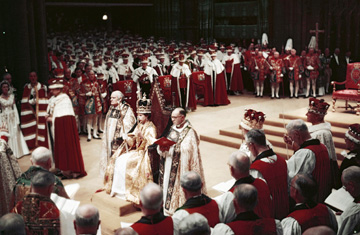
Crowning Glory The Queen at her coronation in June 1953
You sense her approach before you see her. There's a straightening of shoulders among palace staff, a determined clip of shoes on polished floors, and another sound, harder to place, like autumn leaves blown across tarmac. Then a pack of corgis and dorgis — dachshunds crossed with corgis — comes skittering into view, their nails percussive on the sections of parquet not muted by rugs as they surge ahead of their diminutive owner.
One of the first things people notice about the Queen is how closely she fits their expectations, whether she is accompanied by a retinue of corgis or of courtiers, is dressed down in dowdy daywear or gussied up in silks and tiara. The second is how tiny she is. Today's second longest-serving monarch (after Thailand's King) may look too petite to shoulder her extraordinary mass of accrued experience and global celebrity. Yet in other respects she is exactly as we imagine her: regal and serious-minded, familiar yet enigmatic.
The great 19th century essayist Walter Bagehot wrote of the monarchy, "Its mystery is its life. We must not let in daylight upon magic." This precept still holds, perhaps more so than ever in an age of disposable celebrity. The Queen does not make herself available for interviews and has no intention of ever doing so. Her enduring popularity — and the longer-term survival of the constitutional monarchy — rests on a notion rarely articulated in our egalitarian times: that she and her heirs are special, set apart, above the hoi polloi. In at least some respects, that otherness isn't just a notion. On closer observation, the Windsors, especially the monarch's generation and her children's, turn out to be quite unlike most Britons, much less the peoples of the farther-flung Commonwealth realms that still bend the knee to Elizabeth II. The rarefied environment the royals inhabit makes them see things differently — and sometimes not at all. Prince Andrew, on a 2004 visit to China, told students at Peking University that U.S. culture had exerted little influence on British culture. The students looked back at him, bemused, perhaps more aware than their English visitor of how American TV, pop music and fashion have shaped the tastes and cultural output of his country for generations. The royals' upbringing means they do not always naturally connect with the people that they are taught they are born to serve. But connect with them they must.
Only rarely has the Queen badly misjudged public sentiment. In 1966 she was criticized for being remote and out of touch when she did not rush straight to the South Wales town of Aberfan after a landslide of coal waste buried a school, killing 116 children and 28 adults. She drew negative comment again for missing the funeral of 10-year-old Joanne Flannigan, the first service for a local victim of the 1988 downing of Pan Am Flight 103 over the Scottish town of Lockerbie. "Broken-hearted Britain watching TV needed to see their equally grieving monarch," wrote columnist Jean Rook in the Daily Express. The movie The Queen dramatized the sovereign's most serious misstep of all, when she delayed her return to London to lead the national mourning after the 1997 death of her former daughter-in-law.
Diana, unlike the Windsors, was plugged into the demotic, democratic world outside the palace gates. As celebrations for the Diamond Jubilee encourage us to look back over the second Elizabethan era, it is tempting to see the monarchy and its matriarch as relics, preserved in a sticky aspic of nostalgia and sentiment. That would be to underestimate an institution that, against all odds, is quietly thriving and a sovereign who, at 86, is more influential than for many a decade. Her leadership has steered the monarchy through crises and social upheaval. She has built an organization highly skilled at change management. And now it is preparing for the biggest change it will ever have to manage: one day to manage without her.
